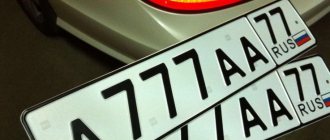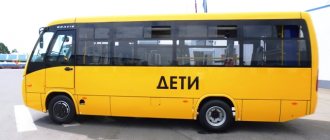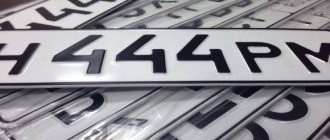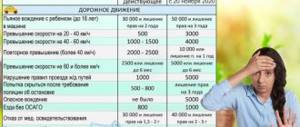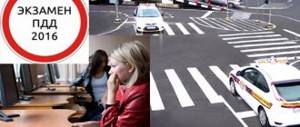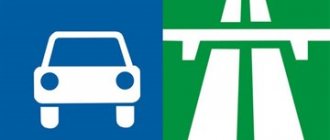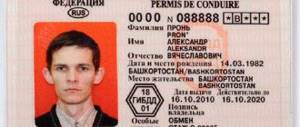Which driver violated the stopping rules?
| 1. | Only the driver of a passenger car. |
| 2. | Truck driver only. |
| 3. | Both violated. |
Both drivers violated the stopping rules, since stopping on highways is allowed only in special parking areas marked with a parking place sign or a rest area sign. In addition, the driver of the car stopped to the left of the edge line, i.e. on the roadway.
New terms learner and driving instructor in traffic rules
In clause 1.2 of the Traffic Regulations, from January 1, 2021, two new terms will appear: “Driving teacher” and “Driving student.”
“Driving teacher” is a teaching employee of an organization carrying out educational activities and implementing basic professional training programs for drivers of vehicles of the relevant categories and subcategories, whose qualifications meet the qualification requirements specified in the qualification reference books and (or) professional standards (if any), teaching driving vehicle.
A driving teacher is a driving instructor, and first of all he is a teacher. He must have the appropriate qualifications and must work in an organization that teaches the driving profession, i.e. at a driving school.
“Driving student” is a person who undergoes appropriate vocational training in the prescribed manner in an organization that carries out educational activities and implements basic vocational training programs for drivers of vehicles of the relevant categories and subcategories, who has initial skills in driving a vehicle and has mastered the requirements of the Rules.
The main concept in the term “learning to drive” is a person undergoing training and having initial skills in driving a vehicle, including having mastered the requirements of the Road Traffic Rules.
Those. Until a driver candidate has mastered initial driving skills and learned the traffic rules, he will not be allowed to take driving lessons. Training in initial driving skills will traditionally take place in closed areas and race tracks.
With the introduction of new terms, changes and additions were made to Section 21 of the Traffic Rules - Driving Practice.
Which drivers violate the rules for turning around on the highway?
| 1. | Both are violating. |
| 2. | Only the driver of a truck performing repair or cleaning work. |
| 3. | Only the driver of a passenger car. |
| 4. | Both do not violate. |
Turning in technological gaps in the dividing strip on highways is prohibited except for road maintenance vehicles with an orange or yellow flashing light turned on when performing repair or cleaning work.
Driving time standards for trucks and buses
New question 11-17 from the CD contains information about the truck and bus driving time standards introduced on January 1, 2021:
Mode for driving personal trucks and buses
Standards for driving and rest time apply to individuals operating:
Ticket 11, question 17 (CD set).
- Trucks with a permissible maximum weight of more than 3.5 tons.
- Buses.
- All listed vehicles.
A comment:
The situation is regulated by the note to clause 26.4 of the traffic rules:
Note. The provisions of this section apply to individuals operating trucks with a permissible maximum weight exceeding 3,500 kilograms and buses. These individuals, at the request of officials authorized to carry out federal state supervision in the field of road safety, provide access to the tachograph and the driver card used in conjunction with the tachograph, and also print information from the tachograph at the request of these officials.
The correct answer is third.
While driving along the highway, you can make a stop:
| 1. | Any place to the right of the line marking the edge of the roadway. |
| 2. | Any place at the edge of the roadway. |
| 3. | Only after 500 m. |
In this situation, you can stop only after 500 m at a special site, as indicated by the rest area sign. Stopping outside special areas on highways is prohibited.
Changes to traffic rules CD tickets January 2, 2021
Ticket 3 question 17
The text of the question and answers has been completely changed:
What equipment must a motor vehicle used for driving instruction have?
1. Additional clutch pedals (except for vehicles with automatic transmission) and brakes.
2. Rearview mirror for teaching driving.
3. Identification marks “Training vehicle”.
4. All listed equipment.
Ticket 11 question 17
The text of the question and answers has been completely changed:
Standards for driving and rest time apply to individuals operating:
1. Trucks with a permissible maximum weight of more than 3.5 tons.
2. Buses.
3. All listed vehicles.
Ticket 12 question 1
The text of the question has been changed, the answers remain unchanged:
In what cases can the owner of a truck with a permissible maximum weight of more than 7.5 tons transfer control of this vehicle in his presence to another person, having the appropriate insurance policy or information printed on paper about the conclusion of the corresponding compulsory insurance agreement in the form of an electronic document compulsory insurance policy civil liability insurance on paper or in the form of an electronic document or a copy thereof on paper?
1. If this person has a driver’s license for the right to drive a vehicle of subcategory “C1”
2. If this person has a driver’s license for the right to drive a category “C” vehicle.
3. In both of these cases
Ticket 12 question 16
The correct answer has been changed from “Prohibited” to “Allowed”:
Is practice driving allowed on the motorway?
1. Prohibited.
2. Allowed only in the far right lane.
3. Allowed.
Ticket 31 questions 16
Changed the correct answer from “Forbidden” to “Allowed”:
Is driving instruction allowed on this road?
1. Prohibited.
2. Allowed only on the rightmost lane of the roadway.
3. Allowed.
Ticket 39 question 1
The text of the question and answers has been completely changed:
In what form is the submission for verification of an insurance policy of compulsory civil liability insurance provided?
1. On paper.
2. In the form of an electronic document or its copy on paper.
3. In any of the listed types.
Ticket 40 question 1
The text of the question has been changed, the answers remain unchanged:
At the request of which persons it is necessary to submit for verification a driver's license for the right to drive a vehicle of the corresponding category or subcategory, an insurance policy of compulsory civil liability insurance or information printed on paper about the conclusion of a compulsory insurance agreement in the form of an electronic document, registration documents for a vehicle on paper or in the form of an electronic document or a paper copy thereof?
1. Police officer.
2. An employee of the Military Automotive Inspectorate.
3. Any traffic controller.
4. All listed persons.
Are you allowed to take the lead in this situation while driving a truck?
| 1. | Yes, if the permissible maximum weight of your car is less than 2.5 tons. |
| 2. | Yes, regardless of the maximum permissible weight of your vehicle. |
| 3. | No. |
On all roads with three or more lanes for traffic in one direction, trucks with a permissible maximum weight of more than 2.5 tons are allowed to enter the leftmost lane only for turning left and making a U-turn. That is, you can drive into the leftmost lane to get ahead only if the permissible maximum weight of your car is less than 2.5 tons.
Driving school students will be allowed to travel on highways
The Ministry of Internal Affairs proposes to change the procedure for taking the exam for obtaining a driver's license. The changes concern mainly the examination procedure. But the most important police initiative, according to auto experts, is the intention to allow students to drive onto highways.
“Taking into account the development of the road network and the presence of highways in their characteristics that do not differ from highways, but are not indicated by the corresponding road sign, the restriction on educational driving on highways is currently incorrect. In connection with this, the draft resolution provides for the lifting of the ban on educational driving on highways,” said the head of the Russian Federation of Car Owners, Sergei Kanaev, in the press-Russian newspaper. — In the USA, when taking an exam, the student is allowed to go wherever he wants. You can even study in your own car. They don’t have any platforms.”
Another initiative of the Ministry of Internal Affairs is the exclusion of the “platform” standard from the process of passing the driver’s test.
Legal experts of the Ministry of Internal Affairs propose to combine the “site” and “city” standards. That is, immediately after the theory, so that the car enthusiast goes out onto city streets. The police also propose to exclude the “playground” from driving school training programs. The site is a fenced section of the roadway on which cones and an overpass are installed (for passing the standard - starting a car stopped on an incline). With the help of placed cones, motorists passed several exercises - “snake”, “parking”, “entering the garage”.
“The site is a training base where people learn some skills, nothing more. Taking an exam on them is not an objective analysis of how a person can drive,” says the head of the federation of car owners.
“The student learned to drive like a snake, drive onto an overpass, all this is necessary, but this is not an indicator. It is necessary to test driving skills in the city,” noted auto expert Kanaev.
But it was decided to leave the “platform” for motorcyclists.
“The practical exam for the right to drive motor vehicles remains in its current version - on sites closed to the traffic of other vehicles and pedestrians,” the press center of the Ministry of Internal Affairs said.
However, there is a caveat - if it is impossible to perform special maneuvers in closed areas, verification of their implementation can be carried out on sections of roads or territories restricted for the movement of other vehicles and pedestrians.
The draft government resolution has been submitted for public discussion.
Which drivers are breaking the rules?
| 1. | All drivers. |
| 2. | None of the drivers. |
| 3. | Only the tractor driver. |
| 4. | Only the driver of a passenger car. |
| 5. | Truck and tractor drivers. |
On highways, the Rules prohibit the movement of vehicles whose speed, due to their technical characteristics or condition, is less than 40 km/h, as well as the movement of trucks with a permissible maximum weight of more than 3.5 tons beyond the second lane. Therefore, the violators are truck and tractor drivers.
Test yourself in matters of speed.
TEST AND STRENGTHEN YOUR KNOWLEDGE
According to the traffic rules.
Topic -10. ( lesson-2) Consolidation of knowledge on the material covered using self-test questions.
1 question.
When approaching which of the following vehicles is the driver obliged to reduce speed and, if necessary, stop?
- 1. Having the identification sign “Disabled”
2. Having the identification sign
“Transportation of children.
3. Having the identification mark
“Transportation of people”
4. In the cases listed
in paragraphs 2 and 3.
5. In all of the above cases.
2-Question.
The driver is prohibited from suddenly braking:
- 1. To stop before an intersection or pedestrian crossing when the traffic light turns yellow after green. 2. Unless required to prevent a traffic accident. 3. In both of the above cases.
3-Question.
When the speed increases three times, the braking distance increases:
- 1. Three times. 2. Six times. 3. Nine times.
4-Question.
What is the maximum speed limit for driving lessons on motorways?
- 1-40km/h. 2-50km/h. 3-70km/h. 4-Driving practice on roads marked with sign 5.1 “Highway”. Prohibited.
5-Question.
How does the magnitude of centrifugal force change with increasing cornering speed?
- 1. Does not change. 2. Increases in proportion to speed. 3. Increases in proportion to the square of the speed.
6-Question.
What actions of the driver will lead to a decrease
in the centrifugal force
generated when the car moves around a turn?
- 1. Increasing the speed of movement. 2. Reducing the speed of movement. 3. Reducing the turning radius. 4. Increasing turning radius. 5. In the actions specified in paragraphs 2 and 4.
7-Question.
What is the maximum speed
allowed for motorcycles on motorways?
- 1. 110 km/h. 2. 120km/h. 3. 140km/h. 4. 90km/h.
8-Question.
What is the maximum speed
allowed for trucks with a permissible maximum
weight of not more than 3.5 tons
on sections of roads (not highways) outside populated areas?
- 1. 70km/h. 2. 90km/h. 3. 110km/h. 4. 140km/h.
9-Question.
Is it permitted to drive on the highway a vehicle whose speed due to its technical condition is less than
40 km/h?
- 1. Allowed. 2. Allowed only in the far right lane. 3. Prohibited.
10-Question. What is the maximum speed?
Are passenger cars allowed on sections of roads (not motorways) outside populated areas?
- 1. 70km/h. 2. 90km/h. 3. 100km/h. 4. 110km/h.
11-Question.
The driver when choosing a speed in a dense traffic stream.
- 1. Established restrictions. 2. Visibility conditions. 3. Intensity of traffic, speed of traffic flow.
12-Question.
Is practice driving permitted on roads marked with this sign?
- 1. Allowed. 2. Prohibited.
3. Prohibited if the road is included in the list announced in the prescribed manner.
13-Question.
What is the maximum speed allowed for towing motorized vehicles with a flexible hitch?
- 1. 40km/h. 2. 50km/h. 3. 60km/h.
14-Question.
When driving in conditions of limited visibility, the speed must be chosen so that the stopping distance is:
- 1. Longer visibility distance. 2. Less visibility distance. 3. Equal to the visibility distance.
15-Question.
In which of the following cases, when driving a car, is it prohibited to drive outside a populated area (not on highways) at a speed of
90 km/h?
- 1. If there is a sign on the road 3.24 “Maximum speed limit” of 90 km/h. 2. If driving with a trailer. 3. When towing another vehicle. 4. In the cases specified in paragraphs. 2 and 3 5. In all specified cases.
16-Question.
Is the driver allowed to exceed the maximum speed determined by the technical characteristics of the vehicle?
- 1. Yes. 2. No. 3. Yes, if there is a “Minimum speed limit” sign on the road
17-Question.
As speed increases, the driver's field of vision:
- 1. Expanding. 2. Tapers. 3. Does not change.
18-Question.
What is the maximum speed limit for driving in residential areas?
- 1. 20km/h. 2. 30km/h. 3. 40km/h.
19-Question.
What is the maximum speed allowed when transporting people in the back of a truck with a permissible maximum weight of
more than 3.5 tons
outside populated areas?
- 1. 110 km/h. 2. 90km/h. 3. 70km/h. 4. 60km/h.
20-Question
.
Is driving in populated areas allowed at a speed of more than 60 km/h?
- 1. Yes. 2. No. 3. Yes, if you install the appropriate sign “Maximum speed limit” 4. Yes, if you install the appropriate sign “Minimum speed limit”
21-Question.
The vehicle must move in the far right lane if its speed does not exceed:
- 1. 40km/h. 2. 50km/h. 3. 60 km/h, when driving only on highways.
22-Question.
When driving on a sandy dirt road, the driver is advised to:
- 1. Change speed and gear depending on road conditions. 2. Without changing speed, move in a pre-selected gear.
23-Question.
The speed of which oncoming vehicle is perceived to be higher than in reality?
- 1. Large vehicle (bus, road train) 2. Passenger car. 3. Motorcycle.
24-Question.
Is it possible to drive outside the city at night at a speed of more than 90 km/h?
- 1. You can. 2. It is impossible, since the stopping distance will be greater than the visibility distance. 3. Only possible on straight sections of roads, without curves.
25-Question.
Approximately how many meters does a car travel in one second at a speed of
90 km/h?
- 1. 15 meters. 2. 20 meters. 3. 25 meters. 3. 35 meters.
26-Question.
How many meters does a car travel in one second at a speed of
60 km/h?
- 1. 10 meters. 2. 12.6 meters 3. 16.6 meters. 4. 18. meters.
27-Question.
For an experienced driver, traffic speed:
- 1. Above his professional capabilities. 2. Below his professional capabilities. 3. Equal to his professional capabilities.
28-Question.
When driving at a low speed of
30 km/h
, in the dark on unlit sections of roads, it is advisable to:
- 1. Drive with high beam headlights. 2. Drive with low beam headlights. 3. Drive with side lights.
29-Question.
The highest economical speed of a passenger car when driving on modern roads with asphalt concrete pavement is within the limits:
- 1. 40-50km/h. 2. 60-80km/h. 3. 80-100km/h.
30-Question.
From an economical point of view, the optimal speed on a horizontal section of the road should not exceed:
- 1. 40% of the maximum. 2. 50% of the maximum. 3. 70% of maximum.
31-Question.
When driving long distances, the most economical and rational speed at which the driver is less susceptible to fatigue is:
- 1. 60km/h. 2. 80km/h. 3. 90km/h.
32-Question.
When a passenger car is moving, at what speed when the car hits a stationary obstacle for the driver and passengers not wearing seat belts, consequences can occur, with injuries to the head of the chest and spine.
- 1. 20km/h. 2. 40km/h. 3. 60km/h.
33-Question.
- 1. 70km/h.
- 2. 90km/h.
- 3. 110km/h.
4. 140km/h.
34-Question.
In which case, when an obstacle or danger arises, the driver must take measures to reduce speed or safely avoid the obstacle.
- 1. When any obstacle appears. 2. When any danger appears. 3. When a danger and (or) obstacle appears that he was able to detect.
35-Question.
36-Question
37-Question
38-Question
39-Question.
When driving in heavy traffic, to ensure traffic safety, the speed must be maintained:
- 1. More speed of traffic flow. 2. Less traffic speed. 3. Approximate or equal to the flow velocity.
40-Question
41-Question.
Is a driver allowed to exceed the speed indicated on the
“Maximum Speed Limit”
placed on the vehicle?
- 1. Yes. 2. No. 3. Yes, if the vehicle is not carrying dangerous goods. 4. Yes, if the vehicle does not carry children.
42-Question.
Are drivers allowed to drive at too low speeds unnecessarily?
- 1. Prohibited. 2. Allowed. 3. Permitted if it is related to production needs. 4. Permitted during training driving, with the student’s initial skills.
43-Question.
In what cases is it allowed to drive outside the right lane in a vehicle whose speed does not exceed
40 km/h?
- 1. Only when overtaking or passing. 2. Only when changing lanes before turning left or making a U-turn. 3. Only when stopping or parking in permitted cases on the left side of the road. 4. When performing the maneuvers
listed in paragraphs. 1&2. 5. When performing all the listed maneuvers.
44-Question.
How does the amount of adhesion of tires to the road surface change with increasing speed?
- 1. Decreases. 2. Increases. 3. The magnitude of the adhesion force does not depend on the speed of movement.
45-Question.
On which car can increasing driving speed help eliminate skidding of the rear axle?
- 1. Front wheel drive. 2. On rear-wheel drive.
46-Question.
When choosing a speed at night, the driver must first take into account:
- 1. Set speed limits. 2. Visibility conditions. 3. Traffic intensity.
47-Question.
Is a driver allowed to drive at too low a speed unnecessarily?
- 1. Prohibited. 2. Allowed. 3. Permitted if the driver does not interfere with other vehicles.
48-Question
49-Question.
In some cases, when transporting groups of people in the back of a truck, its speed should not exceed 60 km/h.
- 1. Only if transportation is carried out in an open loading platform. 2. In the back of a van. 3. In all of the above cases.
50-Question.
What factors need to be taken into account when choosing the maximum speed of a vehicle.
- 1. Traffic intensity. 2. Road conditions. 3. Weather conditions. 4. Technical condition of the vehicle. 5. All of the above factors.
51-Question. What is the maximum speed for passenger cars on roads outside the city without a median according to the new Rules?
. 1. 110.km/h.
. 2.100. km/hour
. 3. 9o. km/hour
52-Question . What is the maximum speed on roads outside the city for passenger cars on roads with a median?
. 1. 110.km/h.
. 2. 100.km/h.
. 3. 90.km/h.
53-Question. How can a driver compensate for not reacting quickly enough?
. 1. Reducing speed without interfering with other road users.
. 2.Increasing the speed of movement.
. 3.Move slower than the speed of traffic.
RIGHT ANSWERS: 1-2. 2-2. 3-3. 4-4. 5-3. 6-5. 7-3. 8-2. 9-3. 10-4. 11-3. 12-3. 13-2. 14-2. 15-2. 16-2. 17-2. 18-1. 19-4. 20-3. 21-1.
22-2. 23-1. 24-2. 25-3. 26-3. 27-2. 28-2. 29-2. 30-3. 31-3. 32-1. 33-4. 34-3. 35-3. 36-3. 37-3. 38-5. 39-3. 40-2. 41-2. 42-1. 43-5. 44-1. 45-1. 46-2. 47-3. 48-3. 49-3. 50-5. 51-2. 52-1.53-1.
12, total, today
Also interesting for you!
Overtaking: DANGER BY GOOD WILL or UNSURE DO NOT OVERTAKE
Requirements for the technical condition of vehicles. In questions and answers to help students...
Traffic jams - realities of the day
Driving a crossover NISSAN - TERRANO AUTOMATIC. What we learn from is what we will ride on. We…
Make way, part-3.
If only it were in the traffic rules. Or Traffic rules do not tolerate the subjunctive mood. Example…
← Previous post
Next entry →
Leave a comment Cancel reply
Which drivers are breaking the rules?
| 1. | Drivers of a truck with a permissible maximum weight of 3 tons and a moped. |
| 2. | Moped driver only. |
| 3. | Nobody is breaking. |
On any roads that have 3 or more lanes for traffic in a given direction, including highways, trucks with a permissible maximum weight of more than 2.5 tons may occupy the leftmost lane only for turning left or making a U-turn. The movement of mopeds on highways is prohibited by the rules. Thus, the violators are truck and moped drivers.
Driving lessons on motorways
From January 1, 2021 - you can. The paragraph: “Training driving” has been removed from clause 16.1.
Practice driving on the motorway is permitted
Let me remind you that the requirements of highway driving rules also apply to roads marked with sign 5.3 “Road for cars”
Road for cars
Did the driver violate the Rules during a forced stop on the highway?
| 1. | Yes. |
| 2. | Yes, if you didn't put up a warning triangle. |
| 3. | No. |
The driver stopped due to a technical malfunction in accordance with the requirements of the Rules behind a solid marking line and turned on the hazard warning lights. Since he stopped on a highway where stopping is prohibited, he needs to place a warning triangle at a distance of at least 30 m from the vehicle. Otherwise, the driver will violate the Rules.
- 21.1
- 21.2
- 21.3
- 21.4
- 21.5
- 21.6
21. TRAINING RIDING
Reader B:
I'd better start driving soon. They say this is harder to learn than the Rules.
Author:
At the driving school you will practice driving lessons. However, it is allowed to learn to drive cars and motorcycles on an individual basis.
– How much do you need to learn to drive?
?
– About five or six!
– Weeks or months?
– Cars!
Joke
21.1
Initial training in driving vehicles should be carried out in closed areas or race tracks.
Author:
In these places, the student’s entire attention is focused on driving technique. There you will learn how to start, stop, and maneuver.
21.2
Training driving on the roads is allowed only with a trainer and if the trainee has initial driving skills. The trainee must know and comply with the requirements of the Rules
Author:
In a closed area or race track, only driving techniques are practiced. On the road, you will have to simultaneously take into account the surrounding situation and comply with the requirements of the Rules.
Reader A:
It’s not for nothing that we teach the Rules before we start learning to drive.
21.3
The teacher must have with him a document for the right to learn to drive a vehicle of this category, as well as a certificate for the right to drive a vehicle of the corresponding category.
Author:
The rules equate a driving instructor to a driver
Reader A:
We remember that the driver teacher may not wear a seat belt.
Author:
And the student must buckle up.
21.4
A student must be at least 16 years old when driving a car, and at least 14 years old when driving a motorcycle.
Reader B:
At what age can you get a license?
Author:
Driving licenses of categories “B” and “C” are issued upon reaching 18 years of age, and category A (motorcycles) – 16 years of age.
21.5
The mechanical vehicle on which training is carried out must be equipped in accordance with paragraph 5 of the Basic Provisions and have identification marks “Training vehicle”
(Fig. 214).
Reader A:
Nothing is said here about additional clutch and brake pedals for the trainer. I saw that training vehicles are equipped with them.
Author:
Absolutely correct In accordance with paragraph 5 of the Basic Provisions, power-driven vehicles used for driving lessons and owned by a training organization must be equipped with additional clutch and brake pedals
Reader B:
Then, when learning to drive individually, for example, in my own car or in the car of my friends, can I not install additional pedals?
Author:
Yes, in this case, for such a car only the identification sign “Training Vehicle”, installed in accordance with the requirements of clause 8 of the Basic Provisions, and a rear view mirror for the teacher are required. Although please note that additional pedals significantly affect traffic safety and significantly simplify the work of the teacher
21.6
It is prohibited to practice driving on roads, the list of which is announced in the prescribed manner.
Reader A:
Practice driving is prohibited on motorways.
Author:
Right. Driving lessons may also be prohibited by decision of local authorities on other roads, for example, with heavy traffic. A list of such roads is available from the State Road Safety Inspectorate, as well as from driving schools.
Table of contents
Who has the right to teach driving a car other than an instructor?
The question of the possibility of teaching a person to drive on their own most often arises among parents who want to teach primary driving skills to teenage children.
Is it possible to teach someone without a license to drive their own car in the city or on roads outside the city?
Alas, the answer to this question is negative. In accordance with paragraph 21.3 of the Russian Traffic Rules, a person teaching a student how to drive on the roads must have with him a document authorizing him to teach driving a vehicle of this category or subcategory, that is, an instructor’s “credential”.
In addition, traffic regulations require that the vehicle used for training be equipped with redundant controls .
So, we’ve sorted out the city and country roads – only an instructor can teach driving on them . Is it possible to teach a person without a license to drive their car on a site or in an open field? Read about this in the next chapter.
